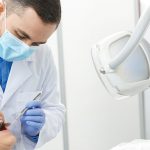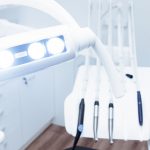Removable prosthesis (removable denture)
If the edentulous area is so much extended that it is not possible to use a fixed prosthesis, i.e. a bridge, it is necessary to prepare a removable prosthesis. Depending on its size, it can be partial (if teeth are available to fix it) or complete denture (in case of an edentulous crest). There are various dentures, may they be partial or complete; a different solution is recommended for almost each patient and the same dental problem can be solved with different denture types.
Dentures can be made of plastic (in case of a complete denture) or metal (in case of a partial denture) or flexible material (for making a temporary denture). If there is a complete edentulousness it may occur that it is not possible to fix the denture properly because of the anatomic conditions, thus it moves in the patient’s mouth. Implants (at least two pieces) help stabilize the denture if the patient’s bone amount is sufficient. (If not, bone graft can also help).) The implant and the denture are fixed to each other with a snap, thus making the denture even steadier.
In case of partial edentulousness the denture can be fixed to the patient’s teeth with a wire clamp; this way there is no need to grind the teeth (like in the case of crowns). However, the clamp is not aesthetic and later it displaces the burdened tooth it is fixed to .There is a combined clasp (fixed to crowns and bridges) that is used for removable prosthesis; it cannot be seen and it is absolutely aesthetic. Besides, it is steady and does not damage the neighbouring teeth.
Preparation of a prosthesis
May it be any kind of a denture, the method of preparation is analogous:
- Impression of the jaw
- Occlusal vertical dimension modification
- Testing with teeth placed in wax
- Prosthesis preparation by a dental technician
This process takes two weeks; a complicated job may take three weeks.
Potential complications after prosthesis preparation
The patient and his/her facial muscles both need to get used to the new prosthesis; at first it may be a strange feeling while speaking and chewing. The dentist can correct the denture if necessary so it is advised for the patient to keep in touch with the dentist. It is essential to clean the prosthesis after each meal and to use denture cleansing tablet (at least once a week) as bacteria and funguses spread easily under the denture, and this may lead to inflammation. The prosthesis, which is out of use, has to be kept dry. It is advised to have a new prosthesis made after eight years.


